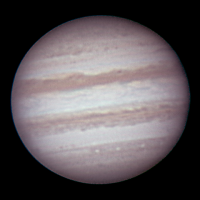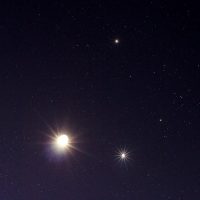Looking ahead to 2017 it appears that the skies will be kind to us this coming year. We have good meteor showers, a total eclipse of the Sun, a bright comet or two, and the usual planetary conjunctions to look forward to. Below you will find some on my notes to what we can look forward to during the coming year.

Covered are elongations for Mercury and Venus, interesting conjunctions, oppositions, eclipses and meteor showers. Posts include notes for visibility in the Hawaiian islands for those events that are location dependent.
Planets
Mercury starts out the year in the dawn sky, with maximum elongation on January 18th. The best evening apparition of Mercury will be in July at 27.2°E.
| Mercury Events for 2017 | ||||
|---|---|---|---|---|
| Date UT | Separation | Mag | ||
| Maximum Elongation | Jan 19 | 24.1°W | +0.0 | |
| Superior Conjunction | Mar 6 | |||
| Maximum Elongation | Apr 1 | 19.0°E | +0.2 | |
| Inferior Conjunction | Apr 19 | |||
| Maximum Elongation | May 17 | 25.8°W | +0.7 | |
| Superior Conjunction | Jun 21 | |||
| Maximum Elongation | Jul 30 | 27.2°E | +0.6 | |
| Inferior Conjunction | Aug 26 | |||
| Maximum Elongation | Sep 12 | 17.9°W | -0.1 | |
| Superior Conjunction | Oct 8 | |||
| Maximum Elongation | Nov 24 | 22.0°E | -0.1 | |
| Inferior Conjunction | Dec 12 | |||
| Source: NASA Sky Calendar and the Mercury Chaser’s Calculator | ||||
Venus starts the year dominating the evening sky as it approaches maximum elongation on January 12th. It will spend the next two months as the evening star before passing through inferior conjunction on March 2th to become the morning star for the remainder of the year. It will see maximum western elongation on June 3rd.

| Venus Events for 2017 | ||||
|---|---|---|---|---|
| Date UT | Separation | Mag | ||
| Maximum Elongation | Jan 12 | 47.1°E | -4.4 | |
| Inferior Conjunction | Mar 25 | |||
| Maximum Elongation | Jun 3 | 45.9°W | -4.3 | |
| Source: NASA Sky Calendar | ||||
There is no Mars opposition this year, the next opposition of the red planet will be July 27th, 2018. The 2018 Mars opposition will be the best since 2003 with the planet appearing larger than 24″ for several weeks.
Jupiter will go through opposition April 7th, while Saturn will see opposition on Jun 14th.
Eclipses
The astronomical highlight of 2017 will undoubtedly be the August total solar eclipse. The path of totality sweeps across Oregon, Idaho and into the midwest, exiting the continent over South Carolina. The path will allow this event to be enjoyed by a very large part of the US population. For the islands this eclipse will be a minor partial eclipse, set up your travel plans now!

There is a penumbral lunar eclipse on February 11th and a minor partial lunar eclipse on August 7th. Neither of these events will be visible in Hawaii.
Comets
This February will feature a very close approach of Comet 45P/Honda–Mrkos–Pajdušáková. The comet will pass about 0.08AU (11.9 million km or 7.4 million miles) from Earth on February 11th, making it an east telescopic object, and a marginal naked eye comet at around 6th magnitude.
Meteor Showers
2017 is a pretty good year for the reliable annual meteor showers. While moonlight can drown out the show, this year the Moon is cooperative and provides little interference for the major showers.
The moonlight circumstances for optical observations of the three strongest annual shower peaks bring a crescent Moon for the Quadrantids (almost first quarter), a gibbous waning Moon for the Perseids and essentially no moonlight interference for the Geminids. Conditions for the maxima of the Lyrids, the Orionids, and the Leonids are also favourable. The essential morning hours for the η-Aquariids are left with no moonlight, while the Southern δ-Aquariids reach their peak near first quarter, and the Ursids are fine, too. So 2017 is a good year to follow the activity of most strong and medium showers with little or no moonlight interference. –IMO 2017 Meteor Calendar
First up are the Qaudrantids, peaking on January 3rd. This year looks to be typical, with a ZHR of around 120. This shower is quite concentrated, with almost no activity seen a day either side of peak. Peak favors western hemisphere observers, predicted for January 3, 14:00UT, or about 4am in the islands. With no Moon in the sky this one may very well be worth watching.
Enjoy!
There is plenty to look forward to in astronomical events during 2017. I hope you find at least a few nights to get out under the star. Like most in the astro community I have already made many of my plans for the upcoming total eclipse. I also hope to get out more often with a telescope and enjoy clear Mauna Kea skies.
While politics and social issues might cause turmoil in our lives we can at least enjoy an occasional night under the stars to put things in perspective and perhaps find a little solace.

